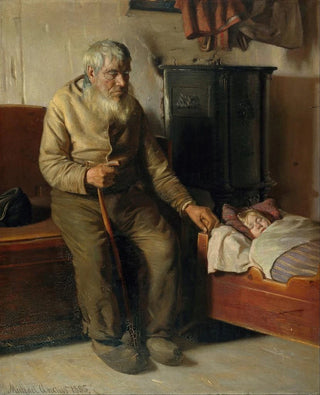Art print | Kristian, blind, taking care of a child - Michael Ancher


View from behind

Frame (optional)
In the fascinating universe of art, some works manage to transcend time and space, captivating the viewer's eye and mind. "Kristian, blind, caring for a child" by Michael Ancher is a perfect example. This piece, imbued with tenderness and delicacy, depicts a touching scene where human vulnerability blends with the sweetness of intergenerational bonds. The Danish artist, known for his ability to capture everyday life with emotional depth, invites us to immerse ourselves in a moment of intimacy, where the viewer's gaze rests on the delicate gestures of a blind man caring for a child. This painting, both simple and poignant, provokes reflection on perception and compassion—universal themes that resonate across ages.
Style and uniqueness of the work
Michael Ancher's style is characterized by a masterful use of light and color, which give his works a lively and dynamic atmosphere. In "Kristian, blind, caring for a child," the artist skillfully plays with shadows and highlights, creating a striking contrast that emphasizes the expressions of the characters. The color palette, both soft and warm, evokes a sense of serenity and peace. Every brushstroke seems charged with emotion, making palpable the connection between the two protagonists. Ancher succeeds in immortalizing a moment of tenderness, where the blind man, despite his disability, demonstrates infinite attention and gentleness toward the child. This painting stands out for its ability to evoke deep feelings while remaining rooted in tangible reality, making it a unique work within the artistic landscape.
The artist and his influence
Michael Ancher, an emblematic figure of the Danish artistic movement, is recognized for his contribution to realism and impressionism. Born in 1849, he established himself as a master in depicting everyday life, often inspired by his environment and the people around him. His commitment to authentic representation of subjects, whether fishermen or others, reflects his dedication to capturing genuine human experiences.

Matte finish

View from behind

Frame (optional)
In the fascinating universe of art, some works manage to transcend time and space, captivating the viewer's eye and mind. "Kristian, blind, caring for a child" by Michael Ancher is a perfect example. This piece, imbued with tenderness and delicacy, depicts a touching scene where human vulnerability blends with the sweetness of intergenerational bonds. The Danish artist, known for his ability to capture everyday life with emotional depth, invites us to immerse ourselves in a moment of intimacy, where the viewer's gaze rests on the delicate gestures of a blind man caring for a child. This painting, both simple and poignant, provokes reflection on perception and compassion—universal themes that resonate across ages.
Style and uniqueness of the work
Michael Ancher's style is characterized by a masterful use of light and color, which give his works a lively and dynamic atmosphere. In "Kristian, blind, caring for a child," the artist skillfully plays with shadows and highlights, creating a striking contrast that emphasizes the expressions of the characters. The color palette, both soft and warm, evokes a sense of serenity and peace. Every brushstroke seems charged with emotion, making palpable the connection between the two protagonists. Ancher succeeds in immortalizing a moment of tenderness, where the blind man, despite his disability, demonstrates infinite attention and gentleness toward the child. This painting stands out for its ability to evoke deep feelings while remaining rooted in tangible reality, making it a unique work within the artistic landscape.
The artist and his influence
Michael Ancher, an emblematic figure of the Danish artistic movement, is recognized for his contribution to realism and impressionism. Born in 1849, he established himself as a master in depicting everyday life, often inspired by his environment and the people around him. His commitment to authentic representation of subjects, whether fishermen or others, reflects his dedication to capturing genuine human experiences.






